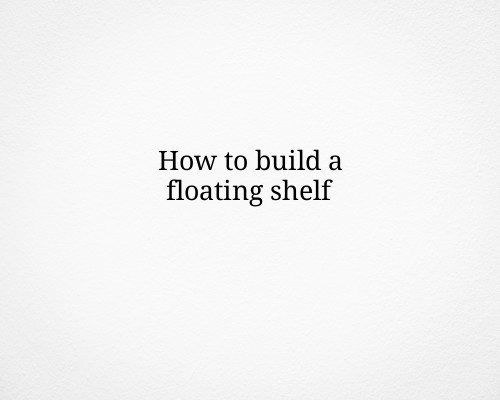Building a floating shelf is a great woodworking project that adds a modern, sleek look to any room. Here’s a step-by-step guide to help you build a sturdy floating shelf:
Materials and Tools Needed:
- Wood: Choose hardwood or plywood for the shelf. The size will depend on how long and deep you want your shelf.
- Wood screws
- Drill
- Level
- Measuring tape
- Stud finder
- L-brackets or floating shelf bracket
- Wood glue
- Sandpaper
- Wood finish or paint
- Screwdriver
- Saw (if needed to cut wood)
Step 1: Plan and Measure
Decide where you want to install the shelf and the dimensions you need. Floating shelves are often 6 to 10 inches deep and can range in length depending on the space. Measure the distance from the floor or surrounding surfaces to determine the placement of your shelf.
Step 2: Cut the Wood
If you need to cut the wood to size, use a saw to make precise cuts according to your measurements. Sand the edges of the wood with sandpaper to ensure a smooth finish.
Step 3: Find Wall Studs
Use a stud finder to locate the studs in the wall where you will anchor the shelf. This is crucial, as you’ll need to attach the brackets to the studs for maximum support. Mark the stud locations with a pencil.
Step 4: Prepare the Brackets
If you’re using floating shelf brackets, these typically consist of a horizontal bracket that slides into a hole in the back of the shelf, keeping it anchored to the wall. If using L-brackets, these will be installed under the shelf and attached to the studs.
For floating shelf brackets: Mark and drill the holes into the back of the shelf according to the bracket’s dimensions. Ensure these holes are placed in a way that the shelf will sit level when mounted.
For L-brackets: Mark and drill holes for the L-brackets under the shelf. If you’re not using floating shelf brackets, you’ll attach the L-brackets directly to the studs in the wall.
Step 5: Mount the Brackets to the Wall
For floating shelf brackets, install the wall anchors into the studs. Make sure they are securely fastened and level. For L-brackets, screw them directly into the studs at the marked spots.
Step 6: Attach the Shelf
For floating shelf brackets: Slide the shelf over the brackets, ensuring the holes in the shelf align with the bracket pins. Secure the shelf with screws or other fastening mechanisms.
For L-brackets: Once the brackets are in place, set the shelf on top of the brackets and screw it into the brackets from underneath.
Step 7: Finish the Shelf
Once the shelf is mounted, give the wood a final sand for a smooth finish. You can then paint, stain, or apply a wood finish of your choice to give the shelf a polished look. Allow the finish to dry completely before adding any items.
Step 8: Add Items to Your Shelf
After everything has dried and settled, you can begin placing items on your floating shelf. Be sure not to overload the shelf with too much weight, as it could affect its stability.
By following these steps, you can create a beautiful, functional floating shelf that adds style and practicality to your space.
For detailed woodworking guides and more tips, check out Ted’s Woodworking Course [here](
